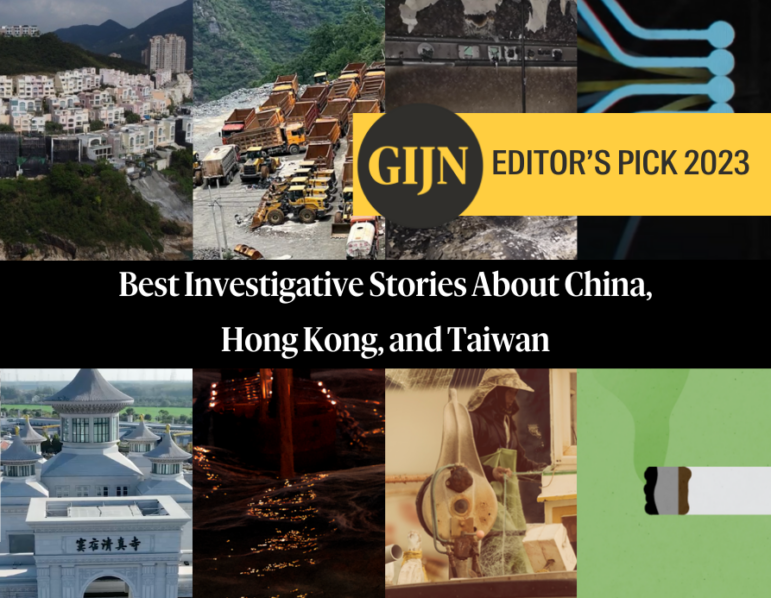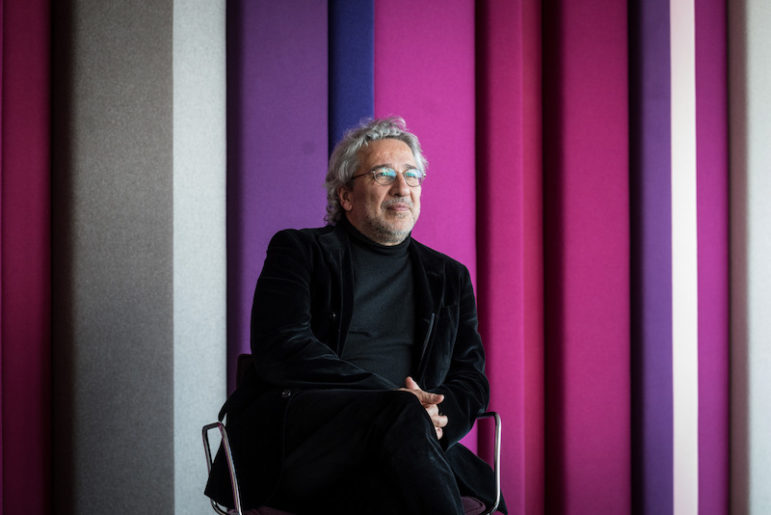

Illustration: Smaranda Tolosano for GIJN
Piercing the Veil of Censorship in China as a Visual Investigator
Investigative reporting in China has become extremely difficult due to the severe deterioration of press freedom in the past decade. Therefore, open source investigations conducted outside China are becoming crucial.
The Visual Investigations team at The New York Times is leading the way when it comes to investigating China related affairs with open source technology. The team blends traditional reporting with advanced digital forensics and has published multiple distinguished investigations on China, including on the COVID-19 outbreak, human rights abuses in Xinjiang, China’s propaganda and surveillance systems, and tracking networks behind secret oil deliveries to North Korea. All these reports have had significant international impact.
Muyi Xiao — the only Chinese journalist on The Times’ Visual Investigations team — has been a significant contributor to these investigations. Born in Wuhan, her entry point into journalism was photojournalism. In 2012, she joined Reuters as a photo editor and later worked as a photojournalist at Tencent News in China. In the summer of 2015, Muyi was chosen as one of seven Magnum Foundation Photography and Human Rights Fellows, and studied at New York University. Right after the fellowship, she was admitted to the International Center for Photography’s (ICP) New Media Narrative program in New York City. In 2017, she became the Visuals Editor of the Asia Society’s online magazine, ChinaFile, and in late 2019, began working with The New York Times’ Visual Investigations team.
At the Times, she is most noted for a piece on how a Chinese doctor who warned about COVID-19 spent his final days. After sounding an early alarm about the coronavirus, Li Wenliang, a doctor in Wuhan, encountered censorship and eventually died from the virus. His death drew massive attention, and the Chinese authorities tightly controlled the information about his passing. Although the news of his death broke during evening prime-time, causing a significant public outcry, it was at first denied by officials, with confirmation only coming in the early hours when people were asleep. Muyi and her colleagues obtained internal documents from the hospital where Dr. Li worked and received treatment. They also interviewed one of Dr. Li’s colleagues who witnessed the resuscitation effort. The story revealed the final days of Dr. Li’s life and how he had to navigate pressure from the hospital and the government while battling a deadly virus. This story was also widely read in China, with Chinese netizens turning the story into screenshots and sharing them on social media.

Muyi Xiao, a native of Wuhan, China, joined The New York Times Visual Investigations team in 2019. Image: Courtesy of The Times
Due to the sensitive nature of the topics Muyi investigates, she has faced severe online harassment. Global Times, a tabloid controlled by the Chinese Communist Party, has attacked her with incendiary claims, such as that she “gave a knife to anti-China forces in the West and murdered her compatriots in the back.”
In this edition of our 10 Questions series, Muyi shares insights on her career trajectory, discusses her favorite investigative projects and tools, and speaks to the broader challenges facing investigative journalism on China issues.
GIJN: Of all the investigations you’ve worked on, which has been your favorite and why?
Muyi Xiao: It is hard to single out a favorite because each holds a special place for me in different ways. One aspect of journalism I personally care deeply about is it being “the first draft of history,” that’s why I enjoy investigative journalism, as it has the luxury of time to paint a fuller picture of events, often getting closer to truth. In this context, I would love to highlight our story that unveiled the final days of Dr. Li Wenliang, who was one of the first people who warned the world about COVID-19 but later tragically succumbed to it.
The pandemic will be talked about for ages, and Dr. Li’s role in it was monumental. I felt a strong responsibility as a journalist to get his story right to the best I could. In his final days, he wasn’t only battling a novel virus, he was also up against the Chinese authorities who tried to silence him. He was an important figure to many people in China and around the world as a medical worker who spoke out for public health and was victimized by censorship.
Before our investigation, there were many unanswered questions around his medical condition and treatment, the political pressure he was under, and even the timing of his passing. Those were difficult questions to answer, mostly due to the sensitivity of the topic and limited access on the ground. For our investigation, we were very fortunate to have interviewed sources who were willing to talk under great risk.
Another challenge is to understand his medical records, given that he contracted the virus very early on in the pandemic when the world knew very little about it. We interviewed eight US-based Chinese medical experts who have experience treating COVID patients or have practiced in Chinese hospitals to carefully assess his condition and treatment.
In the end, our investigation shed light on new essential facts about Dr. Li’s final days. The story received worldwide attention. What is remarkable is that the video even reached a wide audience inside China, despite The Times being blocked there.
GIJN: What are the biggest challenges in terms of investigative reporting in the region you report on?
MX: Censorship. Chinese people could face serious consequences for commenting publicly on sensitive topics, it could be even worse if they share their views with Western news outlets. And it’s not just people inside China who are affected. Chinese people living overseas might also hesitate to talk to us because they worry about loved ones back home. Sometimes, when people are willing to talk, they might not be technically savvy enough to reach out to journalists safely.
GIJN: What’s been the greatest hurdle or challenge that you’ve faced in your time as an investigative journalist?
MX: The biggest challenge for me, on top of the difficult sourcing situation, is to grapple with the risks involved in investigative journalism about China. Not only the risks we personally face, but also the potential repercussions for people we deeply care about. What makes it even tougher is that the situation gets more chilling as time wears on. China never had press freedom, but it wasn’t as dire as it is now under President Xi Jinping. The landscape keeps shifting downward, so we have to adapt constantly, and no one is certain about the right way to navigate it.
GIJN: What is your best tip or trick for interviewing?
MX: I find it helpful to be straightforward when interviewing people for investigative projects, especially when interviewing sources with sensitive information. I don’t want anyone to share information with me under a false understanding of the potential consequences, so I would be very honest about the implications and make sure they understand what it means to talk to me.
GIJN: What is a favorite reporting tool, database, or app that you use in your investigations?
MX: Maybe I should skip this question because the last thing I want to see is that my favorite tool has been blocked by the Chinese government. This is actually a challenge shared by reporters and researchers covering China. We are usually careful about sharing our methods publicly, especially if the tools are developed by Chinese institutions.
For non-Chinese tools, I love spreadsheets and Google Earth.
GIJN: What’s the best advice you’ve gotten thus far in your career and what words of advice would you give an aspiring investigative journalist?
MX: I think it is important to understand why we do what we do, especially for investigative journalists covering China who make significant personal sacrifices for work. The awareness of intention helps journalists set clear goals and boundaries.
GIJN: Who is a journalist you admire, and why?
MX: I really admire the resilience of my colleague Li Yuan, who has been covering China for decades. Amidst a time when many in our field lost faith, she took the initiative to launch a Mandarin-language podcast where she interviews top China experts and people involved in significant news events. She did all the work in her spare time. The podcast has been a great public service for Chinese-speaking people, filling a vital gap in the Chinese-language information ecosystem, where high-quality content on current affairs is scarce.
GIJN: What is the greatest mistake you’ve made and what lessons did you learn?
MX: In the early years of my career, when I was working on a feature story, I didn’t explain clearly to my interviewee the distinction between a journalist and a personal spokesperson. They were not familiar with the workings of journalism and assumed that I would present the event precisely like how they perceived it. So when they saw the story, they were disappointed. This incident taught me the importance of explaining journalistic processes to sources.
GIJN: How do you avoid burnout in your line of work?
MX: I find therapy very helpful. It helps me understand my ambition and limits and when I should stop.
GIJN: What about investigative journalism do you find frustrating, or do you hope will change in the future?
MX: Investigative stories on China, especially on domestic issues, rarely prompt meaningful changes in authorities’ actions and almost always backfire on the journalists. While the stories serve the public’s right to know, they can only serve those with access to the content. So overall, I hope the [Chinese] public can have easier access to high-quality journalism.
Joey Qi is the Chinese editor of GIJN and a journalist from Hong Kong. He has worked for multiple news outlets in Hong Kong, spanning various roles from reporter to editor to management roles. His work focuses on China politics, social issues, and labor rights. He also co-hosted a podcast on social and work-related topics.









